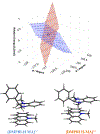Correlation of temperature dependence of hydride kinetic isotope effects with donor-acceptor distances in two solvents of different polarities
- PMID: 37278324
- PMCID: PMC10339711
- DOI: 10.1039/d3ob00718a
Correlation of temperature dependence of hydride kinetic isotope effects with donor-acceptor distances in two solvents of different polarities
Abstract
Recently observed nearly temperature (T)-independent kinetic isotope effects (KIEs) in wild-type enzymes and T-dependent KIEs in variants were used to suggest that H-tunneling in enzymes is assisted by the fast protein vibrations that help sample short donor-acceptor distances (DADs). This supports the recently proposed role of protein vibrations in DAD sampling catalysis. However, use of T-dependence of KIEs to suggest DAD sampling associated with protein vibrations is debated. We have formulated a hypothesis regarding the correlation and designed experiments in solution to investigate it. The hypothesis is, a more rigid system with shorter DADTRS's at the tunneling ready states (TRSs) gives rise to a weaker T-dependence of KIEs, i.e., a smaller ΔEa (= EaD - EaH). In a former work, the solvent effects of acetonitrile versus chloroform on the ΔEa of NADH/NAD+ model reactions were determined, and the DADPRC's of the productive reactant complexes (PRCs) were computed to substitute the DADTRS for the DADTRS-ΔEa correlation study. A smaller ΔEa was found in the more polar acetonitrile where the positively charged PRC is better solvated and has a shorter DADPRC, indirectly supporting the hypothesis. In this work, the TRS structures of different DADTRS's for the hydride tunneling reaction from 1,3-dimethyl-2-phenylimidazoline to 10-methylacridinium were computed. The N-CH3/CD3 secondary KIEs on both reactants were calculated and fitted to the observed values to find the DADTRS order in both solutions. It was found that the equilibrium DADTRS is shorter in acetonitrile than in chloroform. Results directly support the DADTRS-ΔEa correlation hypothesis as well as the explanation that links T-dependence of KIEs to DAD sampling catalysis in enzymes.
Conflict of interest statement
The authors declare no competing financial interests.
Figures


Similar articles
-
Solvent Effects on the Temperature Dependence of Hydride Kinetic Isotope Effects: Correlation to the Donor-Acceptor Distances.J Phys Chem A. 2022 Oct 27;126(42):7675-7686. doi: 10.1021/acs.jpca.2c06065. Epub 2022 Oct 13. J Phys Chem A. 2022. PMID: 36228057
-
Replication of the Enzymatic Temperature Dependency of the Primary Hydride Kinetic Isotope Effects in Solution: Caused by the Protein-Controlled Rigidity of the Donor-Acceptor Centers?Biochemistry. 2019 Oct 1;58(39):4035-4046. doi: 10.1021/acs.biochem.9b00574. Epub 2019 Sep 13. Biochemistry. 2019. PMID: 31478638
-
Direct Correlation between Donor-Acceptor Distance and Temperature Dependence of Kinetic Isotope Effects in Hydride-Tunneling Reactions of NADH/NAD+ Analogues.J Org Chem. 2021 Jun 4;86(11):7500-7507. doi: 10.1021/acs.joc.1c00497. Epub 2021 May 26. J Org Chem. 2021. PMID: 34037396
-
Understanding Biological Hydrogen Transfer Through the Lens of Temperature Dependent Kinetic Isotope Effects.Acc Chem Res. 2018 Sep 18;51(9):1966-1974. doi: 10.1021/acs.accounts.8b00226. Epub 2018 Aug 28. Acc Chem Res. 2018. PMID: 30152685 Free PMC article. Review.
-
Environmentally coupled hydrogen tunneling. Linking catalysis to dynamics.Eur J Biochem. 2002 Jul;269(13):3113-21. doi: 10.1046/j.1432-1033.2002.03022.x. Eur J Biochem. 2002. PMID: 12084051 Review.
Cited by
-
Structural Effects on the Temperature Dependence of Hydride Kinetic Isotope Effects of the NADH/NAD+ Model Reactions in Acetonitrile: Charge-Transfer Complex Tightness Is a Key.J Org Chem. 2024 Mar 1;89(5):3184-3193. doi: 10.1021/acs.joc.3c02562. Epub 2024 Feb 16. J Org Chem. 2024. PMID: 38364859 Free PMC article.
-
Structural Effects on the Hydride-Tunneling Kinetic Isotope Effects of NADH/NAD+ Model Reactions: Relating to the Donor-Acceptor Distances.J Org Chem. 2025 Feb 28;90(8):3110-3115. doi: 10.1021/acs.joc.4c03080. Epub 2025 Feb 13. J Org Chem. 2025. PMID: 39946088 Free PMC article.
-
Study of the Effects of Remote Heavy Group Vibrations on the Temperature Dependence of Hydride Kinetic Isotope Effects of the NADH/NAD+ Model Reactions.ACS Omega. 2024 Apr 24;9(18):20593-20600. doi: 10.1021/acsomega.4c02383. eCollection 2024 May 7. ACS Omega. 2024. PMID: 38737086 Free PMC article.
References
-
- Kohen A; Cannio R; Bartolucci S; Klinman JP Enzyme dynamics and hydrogen tunnelling in a thermophilic alcohol dehydrogenase. Nature 1999, 399, 496–499. - PubMed
-
- Scrutton NS, Basran J, Sutcliffe MJ Review A new conceptual framework for enzyme catalysis. Eur. J. Biochem. 1999, 264 666–671. - PubMed
-
- Antoniou D; Schwartz SD Internal enzyme motions as a source of catalytic activity: rate-promoting vibrations and hydrogen tunneling. J. Phys. Chem. B 2001, 105, 5553–5558.
-
- Knapp MJ; Klinman JP Environmentally coupled hydrogen tunneling. Linking catalysis to dynamics. Eur. J. Biochem. 2002, 269, 3113–3121. - PubMed
Grants and funding
LinkOut - more resources
Full Text Sources

